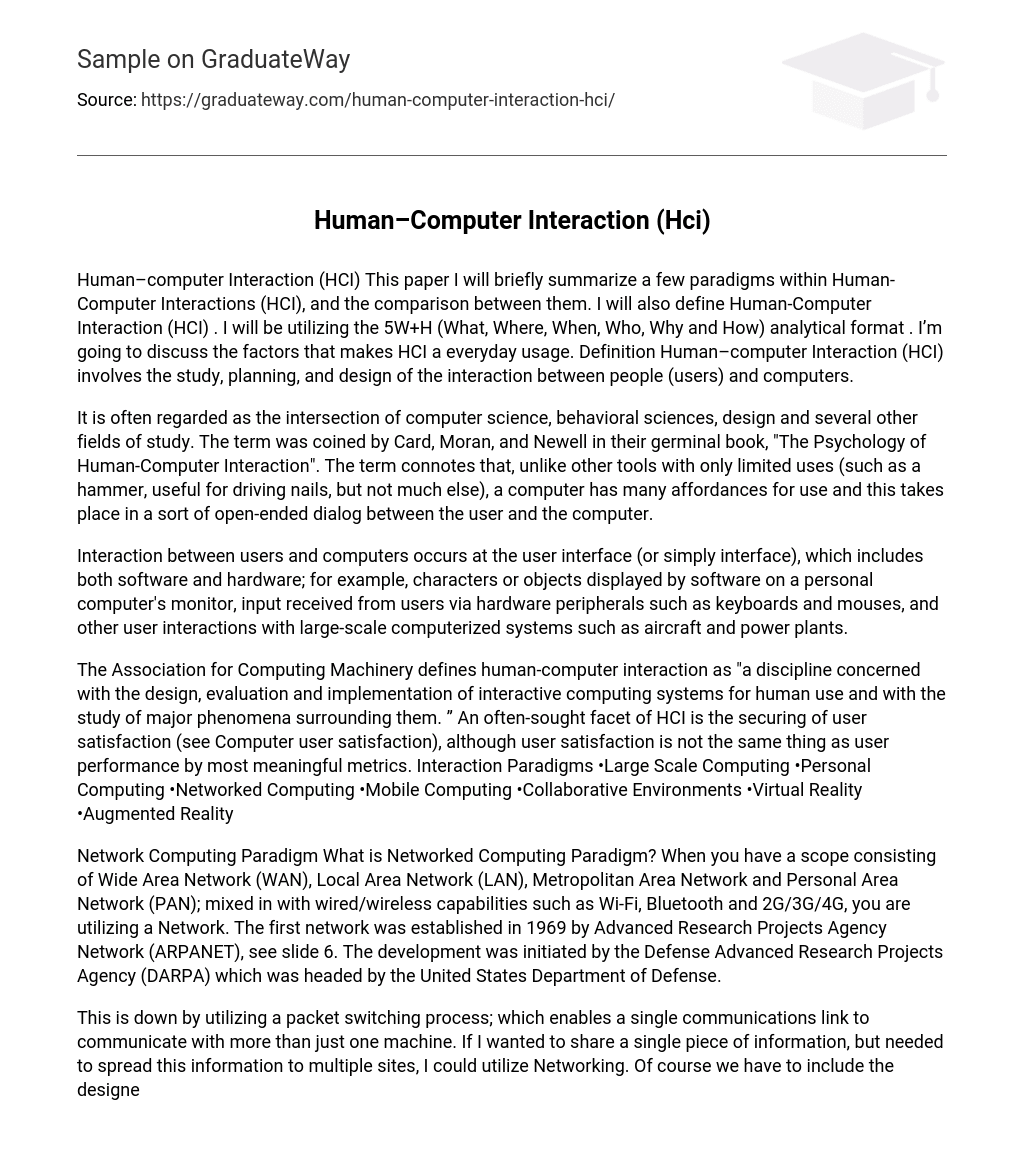Human–computer Interaction (HCI) This paper I will briefly summarize a few paradigms within Human-Computer Interactions (HCI), and the comparison between them. I will also define Human-Computer Interaction (HCI) . I will be utilizing the 5W+H (What, Where, When, Who, Why and How) analytical format . I’m going to discuss the factors that makes HCI a everyday usage. Definition Human–computer Interaction (HCI) involves the study, planning, and design of the interaction between people (users) and computers.
It is often regarded as the intersection of computer science, behavioral sciences, design and several other fields of study. The term was coined by Card, Moran, and Newell in their germinal book, “The Psychology of Human-Computer Interaction”. The term connotes that, unlike other tools with only limited uses (such as a hammer, useful for driving nails, but not much else), a computer has many affordances for use and this takes place in a sort of open-ended dialog between the user and the computer.
Interaction between users and computers occurs at the user interface (or simply interface), which includes both software and hardware; for example, characters or objects displayed by software on a personal computer’s monitor, input received from users via hardware peripherals such as keyboards and mouses, and other user interactions with large-scale computerized systems such as aircraft and power plants.
The Association for Computing Machinery defines human-computer interaction as “a discipline concerned with the design, evaluation and implementation of interactive computing systems for human use and with the study of major phenomena surrounding them. ” An often-sought facet of HCI is the securing of user satisfaction (see Computer user satisfaction), although user satisfaction is not the same thing as user performance by most meaningful metrics. Interaction Paradigms •Large Scale Computing •Personal Computing •Networked Computing •Mobile Computing •Collaborative Environments •Virtual Reality •Augmented Reality
Network Computing Paradigm What is Networked Computing Paradigm? When you have a scope consisting of Wide Area Network (WAN), Local Area Network (LAN), Metropolitan Area Network and Personal Area Network (PAN); mixed in with wired/wireless capabilities such as Wi-Fi, Bluetooth and 2G/3G/4G, you are utilizing a Network. The first network was established in 1969 by Advanced Research Projects Agency Network (ARPANET), see slide 6. The development was initiated by the Defense Advanced Research Projects Agency (DARPA) which was headed by the United States Department of Defense.
This is down by utilizing a packet switching process; which enables a single communications link to communicate with more than just one machine. If I wanted to share a single piece of information, but needed to spread this information to multiple sites, I could utilize Networking. Of course we have to include the designer. Lawrence Roberts, a highly prized scientist, was given, along with his team, the successful task of creating packet switching in the Advanced Research Projects Agency. Mobile Computing Paradigm What is Mobile Computing Paradigm? Mobile computing has taken the world by storm.
Whether it’s a cellular phone, tablet or laptop, you are not confined to stationary computing. Mobile networks utilizes Wi-Fi to communicate between each machines, giving the ability to share photos, files and voice conversations. In 1940s , the military utilized Hand-held radio transceivers; which relied on a radio telephony links. Later Bell Laboratories inherited this process and began placing mobile phones in vehicles in 1946. The race to produce the first handheld mobile phone was reached in 1973 by Motorola, by a researcher named Martin Cooper.
The cellular phones had to utilize a multi-directional, cellular network antenna array; which was developed by Douglas H. Ring and W. Rae Young in Bell Labs. The antennas would transmit/receive in three directions under three different frequencies. Now days we are flooded with a onslaught of mobile options and by choice it is winning the preference race. When we started mobile communicating, our first generation of mobile telephony (0G) needed the operator to setup and place each call individually, now with 4th Generation (4G), we can make phone call around the world and better yet pass data through network computing and satellites.
Conclusion Although in comparison, Mobile computing and Network computing fall under two different categories, they both benefit from Human-Computers Interactions (HCI). Mobile computing relies on a Network computing. Mobile computing offers a multitude of capabilities, such as data processing, on the go communications and document sharing. Network computing provides end-to end solutions that give you the power to connect and communicate. These computers or nodes work together over a network . These paradigms are great contributions to HCI.





